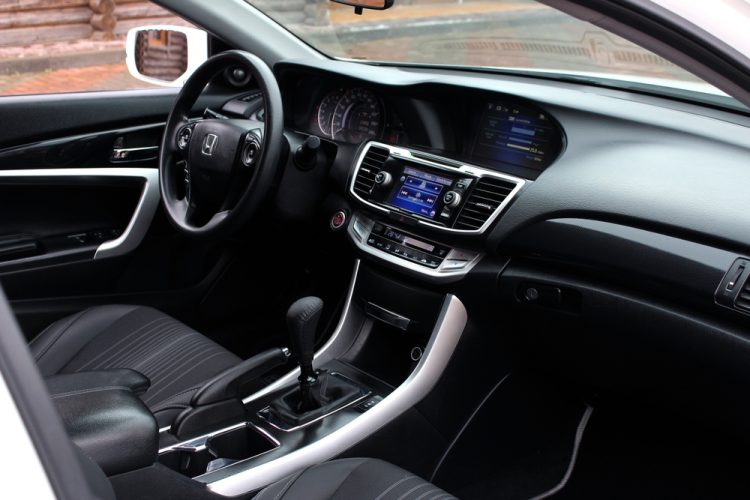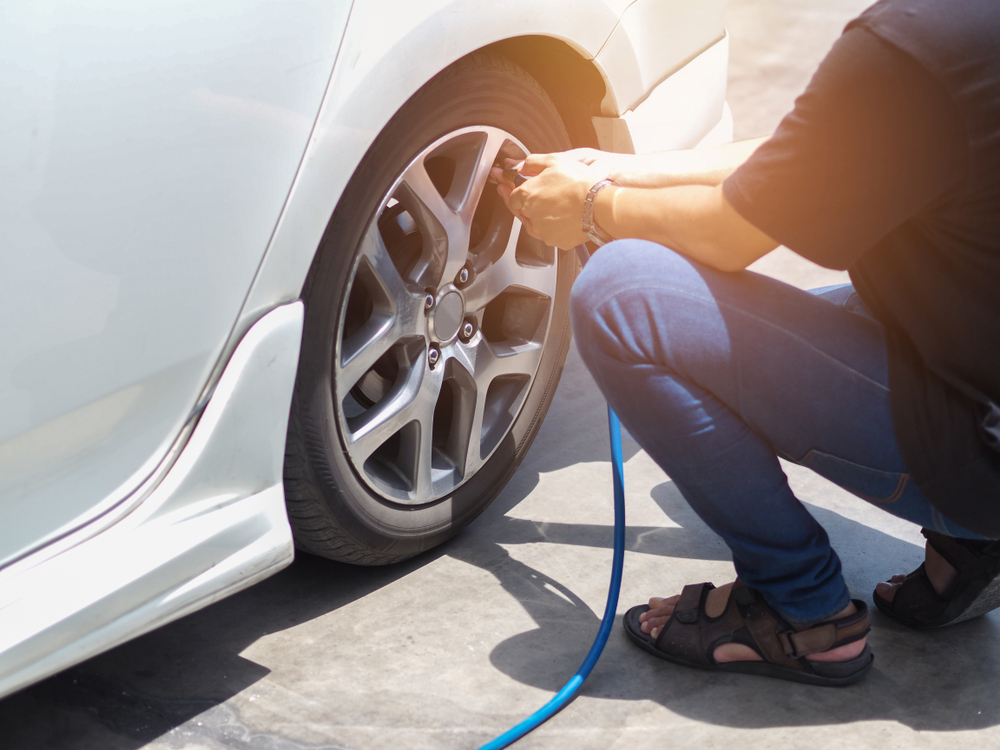
You are driving down the road and suddenly you see it: A dreaded dash indicator light has come on in your Honda Civic. Nobody likes to see any sign that something is wrong with their car, so you pull over and grab the owner’s manual to see what’s happening. If the light is orange and looks like a horseshoe with an exclamation point in the middle, it’s your Tire Pressure Monitoring System (TPMS) most likely alerting you one (or more) of your tires has low air pressure.
Your tire pressure is important for safety and fuel reasons so having low pressure is a problem you need to address sooner rather than later. Drivers operating on low tire pressure will find it harder to control their vehicle, as well as probably noticing they aren’t getting the same fuel economy. Continuing to drive on underinflated tires can cause them to wear out faster, meaning big bucks to replace them more frequently. Likewise, overinflated tires will also wear out more quickly and could cause a loss of traction.
Just as you find the best car insurance to protect yourself and your passengers, you need to take the necessary steps to make sure your vehicle is safe on the road. Having the proper air pressure in your tires is a vital step in the right direction.
Let’s take a look at what drivers need to know and do if they get a message from their TPMS sensor.
What Causes the TPMS Light to Come On?
In most cases, the alert comes on when you have low tire pressure in your Honda Civic. The TPMS system is designed to let you know when the PSI (pounds per square inch) of air pressure in your tires falls below a certain level. Sensors read the level and send you a message with an alarm so you can get off the road and put some air in your tire.
Other things that can cause this include:
- Having different tire types and sizes on your car at the same time, including when the temporary spare is on after a flat.
- The load in the vehicle is heavy and/or uneven.
- Driving in slippery conditions, such as on snow and ice.
- Incorrect or incomplete TPMS calibration.
Remember, cold weather temperatures can cause your tires to lose air, which can trigger your system.
Direct vs Indirect TPMS
Some Honda models have what is called an indirect TPMS system, while other ones have direct TPMS. Direct measures the amount of air in the tire, while indirect counts how many times the wheels turn around. If a tire is low, it will need to revolve more times to go the same distance as a larger tire, since the radius between the axle and the road is smaller.
Since most late model cars come with an Automatic Braking System (ABS) which counts wheel rotation, in the Honda indirect method the ABS is simply counting revolutions for both systems.
According to some experts, the indirect TPMS system is not as accurate as direct and may fail to warn you if a tire loses air. With the direct system, you’ll see a tire pressure reading for each individual tire by looking in your tire monitoring system display.
Preparing to Reset the Tire Pressure Light
Once you’ve filled your low tire to the appropriate pressure, you’ll want to make sure your indicator light turns off. Depending on your model and what year it was released, there are different ways to do this. If it simply will not turn off, you may need to have your mechanic take a look. But here are the main methods for getting things back to normal on your dash panel.
Some older models may have a TPMS reset button located to the left of the steering wheel. If yours is like this, simply press and hold until the TPMS light blinks twice.

Resetting the Tire Pressure Light on Honda Civic
Ensure that your tires have the correct pressure by using a tire pressure gauge. You can find the correct amount of PSI for your Honda by looking on the inside of the driver’s side door.
Starting the Ignition
To turn off the TPMS dash light, the first step is to turn the key in the ignition to where you see your normal dashboard lights. Do not start your car. Turn the key off.
Press the TPMS Button
Press the reset button. On some Honda models it is located under the steering wheel. In the Honda Civic 2019, it is located to the left side of the steering wheel. Press firmly and hold for a few seconds until you see the light begin to flash.
Monitor the TPMS Indicator Light
Once the light has blinked a couple of times, it should go out.
Verify TPMS Light Reset
Turn your vehicle on and make sure your tire pressure is set to the recommended level. The low-pressure light should not be on or flashing.
Using the Touch Display to Turn Off the Display Light
Newer Honda models may come with an audio display touchscreen. Here are the steps to use if your Honda is so equipped.
- From the home screen, select Settings
- Select Vehicle
- Select TPMS Calibration
- Select Calibrate
For models without the touchscreen display, follow these steps:
- Scroll to Customize Settings
- Select TPMS Calibration
- Select Initialize
- Select Yes
- Press Menu to Exit
Adjusting Tire Pressure
Of course, before you can turn your TPMS sensor light off, you must take the necessary steps to get the required air in your tires. Check the inside of your driver’s door to find the recommended tire pressure or read your owner’s manual. Follow these steps to put the correct amount in each tire.
- Remove the tire valve cap and put it somewhere you will be able to find it when you are done
- Use a tire pressure gauge to check your pressure before you start by putting the compressor fitting on the tire valve stem
- Press the tip of the pump to the tire valve. You may hear a loud noise indicating air escaping. Steady the pump tip to the valve and push firmly until you no longer hear the noise. Engage the pump by pressing the handle if it has one. Some do not and will automatically begin to fill your tire when connected.
- Fill the tire with air for a few seconds and check the pressure with your gauge. This will give you an idea of how long you need to hold the pump on the tire. If you’ve barely made a dent in a few seconds, place the pump back on and hold it for longer.
- Do not overinflate! If you do, use your gauge to let air out of the tire.
- Replace the valve stem cap.
Proper Tire Pressure for Honda Civic
As mentioned, one option is to check the manual for the correct PSI, although that information is also on the inside of the driver’s door. Remember, cold weather can trigger your tires to lose air while parked, so don’t be surprised if you start to drive off in the morning after a freeze overnight, only to see your tire light flashing and hear an alarm bell.
It’s a good idea to check your pressure on a regular basis.
Troubleshooting Tips
If you run into problems with either tire pressure or how to how to reset the tire pressure light on a Honda Civic, your options are to take your Honda to a certified mechanic or even a tire shop for help and advice. Most tire shops have the necessary knowledge to help you.
One common issue and solution to the TPMS light not going away is calibration. In some cases, driving for a cumulative 30 minutes at speeds between 30-60 miles per hour will reset the system.
Another solution is to disconnect the battery to clear codes that may be stopping your Honda from resetting.
When to Seek Professional Help
If you cannot clear the system, there may be an issue with the TPMS itself, rather than one or more tires. A professional can check your vehicle’s codes to let you know what is wrong.
Importance of Tire Pressure Monitoring for Overall Vehicle Health
If you are like most people, you’ve invested some cash into your ride. Taking care of the moving parts and systems with regular maintenance is an important part of the package to keeping your vehicle dependable and safe. Checking your tire pressure on a regular basis is just part of that. If you don’t feel like doing it yourself, there are still a few full-service gas stations that will do it for you. Or you might just pull into your regular mechanic’s shop for a quick check.
Keep in mind that underinflated tires are a safety hazard. Never ignore your dash lights when they send you a message about one or more of your systems.
Find Affordable Auto Insurance Online Today to Stay Safe on the Road
Just like regular maintenance, the right insurance is important, too. At Freeway Insurance, we understand how to help you find the perfect balance between budget and need. Give us a call today at (800) 777-5620, get a quick online car insurance quote or stop by one of our locations.



